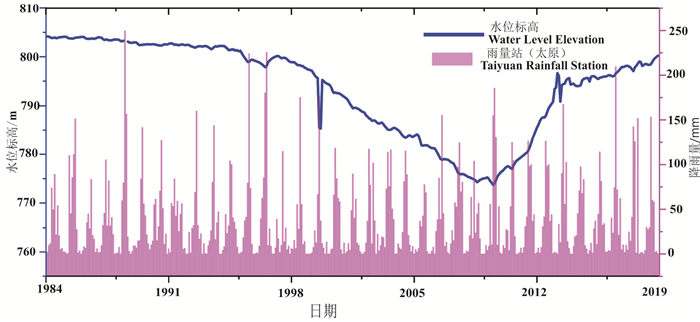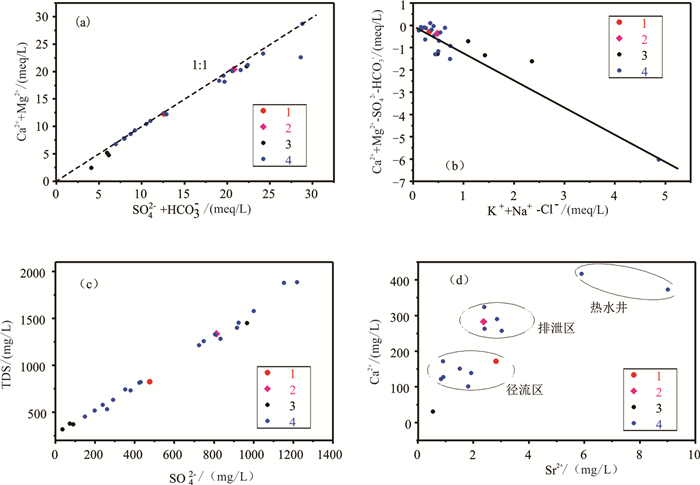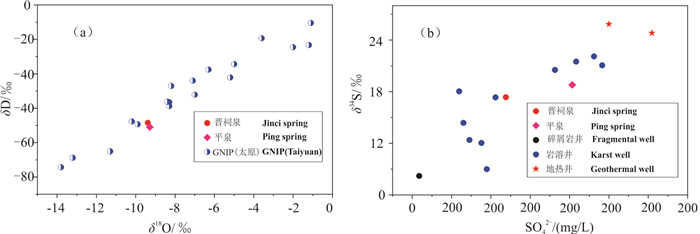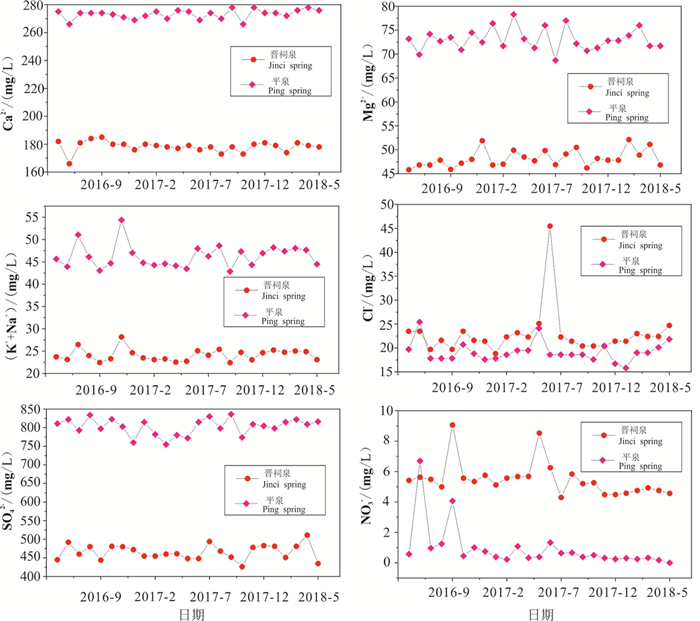The hydraulic connection between Jinci and Pingquan in Taiyuan' Shanxi and its contribution to the reflow of Jinci spring
-
摘要:
晋祠泉出露于山西太原西山悬瓮山下,由难老泉、圣母泉、善利泉组成。1954—1958年实测泉水平均流量为l.94 m3/s。与晋祠泉同处山前断裂带的平泉于1978年成为特大岩溶水自流井水源地,自流量最大达到1.56 m3/s。由于这些自流井的开采,使晋祠泉的流量急剧下降,1994年4月30日断流。研究山西太原晋祠泉—平泉水力联系对晋祠泉复流方案制定具有重要意义。本文以晋祠泉、平泉为研究对象,通过样品采集、水质监测,综合运用水化学(离子比例、硫同位素、氢氧同位素)方法。揭示晋祠泉—平泉水文地球化学特征和环境同位素特征,反映地下水流系统的特征、水力联系特征。得出1980—1992年,晋祠泉地下水水位的变化呈稳定下降趋势,主要原因是有太原化学工业公司、开化沟、淸徐县平泉村和梁泉村等水源地大量开采岩溶地下水,导致地下水水位下降。晋祠—平泉一带岩溶地下水氢氧同位素值较接近,说明这一带岩溶地下水补给来源与补给途径相近。水质监测分析得出晋祠泉与平泉各个离子变化趋势基本一致。说明晋祠与平泉存在紧密的水力联系,因此晋祠泉与平泉必然存在一个比较强的导水通道。可以通过在晋祠泉下游导水通道上帷幕灌浆,提高晋祠泉水水位,使晋祠泉出流。
Abstract:Jinci Spring,which is composed of Nanlao Spring,Shengmu Spring and Shanli Spring,is exposed at the foot of Xishan Mountain in Taiyuan. The average horizontal discharge of Jinci Spring was 1.94 m3/s from 1954 to 1958. Pingquan spring,located in the piedmont fault zone with Jinci spring,became the source of superlarge karst water self-flowing wells in 1978, with the maximum self-flowing rate reaching 1.56 m3/s. Because of the exploitation of these self-flowing wells,the flow of Jinci Spring dropped sharply and was cut off on April 30,1994. The study of the hydraulic connection between Jinci Spring and Pingquan Spring in Taiyuan,Shanxi Province,is of great significance for the formulation of Jinci Spring recharge plan. With Jinci spring and Pingquan spring as the research objects and through sample collection and water quality monitoring,hydrochemistry (ion ratio,sulfur isotope,hydrogen and oxygen isotope) methods were comprehensively applied. The result has revealed hydrogeochemical characteristics and environmental isotope characteristics of Jinci spring to Pingquan spring as well as the characteristics of groundwater flow system and hydraulic connection. From 1980 to 1992, the change of groundwater level in Jinci Spring showed a steady downward trend. The main reason was that a large number of karst groundwater was exploited in Taiyuan Chemical Industry Company,Kaihua Valley,Pingquan Village and Liangquan Village in Zhaoxu County,which resulted in the decline of groundwater level. The hydrogen and oxygen isotope values of karst groundwater in Jinci spring to Pingquan spring area were close to each other,indicating that the source of recharge and the way of recharge were quite similar. Water quality monitoring analysis shows that the change trend of each ion in Jinci spring and Pingquan spring is basically the same,suggesting that Jinci spring and Pingquan spring have close hydraulic connection,so Jinci spring and Pingquan spring must have a strong water channel. The water level of Jinci spring can be raised by curtain grouting on the downstream water channel of Jinci spring,so that Jinci spring can flow out.
-
1. 引言
地下水中的化学成分可以示踪地下水的循环途径, 反映地下水流系统的特征;而地下水水化学类型是地下水化学成分的集中反映,也是地下水水文地球化学特征研究的重要内容之一(袁道先,1990;沈照理和王焰新,2002;王焰新等,2005)。水文地球化学结合同位素示踪的方法可更深入研究区域地下水的循环特征和水动力场特征(刘文波等,2010;李向全等,2011;郭晓东等,2014;袁建飞等,2016;孙厚云等,2018)。晋祠泉出露于太原西山悬瓮山下,由难老泉、圣母泉、善利泉组成,1954—1958年实测泉水平均流量为l.94 m3/s。与晋祠泉同处太原西山山前断裂带的平泉,1978年建立了特大型岩溶水自流井水源地,自流量最大达到1.56 m3/s。由于这些自流井的开采,使晋祠泉的流量急剧下降,1994年4月30日断流。为建设美丽山西,省政府将规划实施晋祠泉复流工程。因此研究晋祠泉的补给来源、晋祠—平泉水力联系成为一项重要课题。
2. 研究区概况
山西太原晋祠泉域位于太原盆地的北部,泉域面积2713 km2(梁永平等, 2019)。其碳酸盐岩含水层为下古生界寒武系和奥陶系,连续沉积厚度超过900 m。晋祠岩溶地下水主要接受西山碳酸盐岩裸露区及覆盖区的降水人渗补给、汾河及支流在碳酸盐岩段的渗漏补给(后期又加入水库渗漏补给)。晋祠泉域岩溶地下水排泄方式主要包括:晋祠泉、平泉、通过西山边山断裂带向盆地内松散层的潜流排泄以及人工开采井。晋祠泉位于北北东向晋祠断裂之南端,位于岩溶发育的排泄区,为西山岩溶地下水的天然集中排泄点,断裂西侧出露有奥陶系峰峰组石灰岩,断裂东侧为第四系松散层,岩溶地下水向东遇第四系松散层的阻挡而沿断裂上升溢出地表形成泉水(图 1)。晋祠泉群泉总流量在20世纪50年代平均为1.95 m3 /s,60年代为1.61 m3 /s,70年代为1.21 m3 /s,80年代为0.52m3/s(晋华等, 2005)。1960年以前基本上为天然动态。平泉则位于交城至清徐的北东东向断裂带之北端,晋祠泉的下游,是西山岩溶地下水的人工排泄点之一,泉水出露高程为784.31~86.87 m。2011年8月,清徐县平泉村“不老泉”和沙河底“水巷”两处泉水呈现复流迹象。2016—2018实测群泉总流量分别为0.067 m3/s、0.084 m3/s、0.114 m3/s。
3. 研究技术与方法
通过开展野外地质、水文地质补充调查,查明晋祠、平泉水文地质条件。于2016年5月在晋祠泉域边山断裂带取样24组。其中简分析9组,全分析15组(表 1)。2016年5月—2018年5月布置水质长观点两处,分别为晋祠泉口岩溶井、平泉村不老池泉水。pH、温度、电导率等指标直接通过WTW多功能水质监测仪现场测试获得;Ca、HCO3离子由德国默克测试盒现场滴定。化学分析在中国地质科学院岩溶地质研究所国土资源部重点实验室完成。2H/18O同位素(中国地质科学院岩溶地质研究所国土资源部重点实验室)测定精度分别为±2.0‰和±0.1‰;δ34S值在中国地质调查局武汉地质调查中心实验室完成测试,δ34S值采用IsoPrime质谱仪进行测定,δ34S值采用CDT(Canyon Diablo Meteorite)标准,测试精度优于±0.1‰。所有水样阴阳离子平衡相对误差小于5%,利用水化学模拟软件Phreeqc计算矿物饱和指数;利用Origin软件绘制离子比例系数图、同位素分析。
表 1 取样点基本信息Table 1. The information of sampling point
4. 晋祠—平泉水力联系分析
4.1 水位动态特征
地下水位动态变化,是反映含水层中地下水资源量变化的一个指征,地下水位的上升或下降,直接反映了地下水补给与消耗量的变化(陶虹等, 2013)。根据地下水水位动态监测资料分析,在1980年前,地下水水位的变化随降水量的大小而变化,呈稳定状态(图 2);1980—1992年,晋祠泉地下水水位的变化呈稳定下降趋势,主要原因是有太原化学工业公司、开化沟、淸徐县平泉村和梁泉村等水源地大量开采岩溶地下水,导致地下水水位下降;1993—2005年,整个泉域地下水水位急剧下降,主要原因是岩溶水开采量急剧加大和降水量减少(图 3);2005—2012年,泉域地下水水位呈上升趋势,主要原因是万家寨引黄工程,“关井压采”,部分工矿企业置换利用黄河水,中小煤矿整治与关停,汾河实施清水复流工程(二库修建),使泉域内岩溶地下水水位有明显回升(图 2)。
![]() 图 3 晋祠泉流量与岩溶水开采量变化趋势对比曲线(a)及晋祠泉—平泉流量关系线(b),资料来源山西省第一水文地质工程地质队;1—晋祠泉流量;2—晋祠泉域岩溶地下水开采量;3—平泉流量Figure 3. Comparison curve of Jinci spring discharge and karst water exploitation(a) and the discharge relation between Jinci spring versus Pingquan spring(b)1-Jinci spring flow; 2-Karst groundwater exploitation in Jinci spring area; 3- Pingquan spring flow
图 3 晋祠泉流量与岩溶水开采量变化趋势对比曲线(a)及晋祠泉—平泉流量关系线(b),资料来源山西省第一水文地质工程地质队;1—晋祠泉流量;2—晋祠泉域岩溶地下水开采量;3—平泉流量Figure 3. Comparison curve of Jinci spring discharge and karst water exploitation(a) and the discharge relation between Jinci spring versus Pingquan spring(b)1-Jinci spring flow; 2-Karst groundwater exploitation in Jinci spring area; 3- Pingquan spring flow4.2 水化学特征
岩溶水化学成分受区域内的地质条件、水动力条件和人类工程活动等因素的控制,并能够较好的保存这种影响“信息”。因此,水文地质工作者经常利用水文地球化学方法研究复杂的岩溶水系统(Smykatz-Kloss et al., 1990; Fairchild et al., 2006; Musgrove et al., 2010; Rui Ma et al., 2011;唐春雷等,2019)。依据工作所取得岩溶地下水,碎屑岩井水样分析结果,得出岩溶水pH值6.92~7.86,均值为7.35。钙离子95.3~417.0 mg/L,均值为226.9 mg/ L。硫酸根离子149~1219 mg/L,均值为633 mg/L。碎屑岩井水30.5~73.1 mg/L,均值为60.0 mg/L。硫酸根离子35~90 mg/L,均值为66 mg/L。岩溶水(泉)总体特征表现为阳离子高钙镁、低钾钠,阴离子低氯,高硫酸根。按照舒卡列夫分类法,研究区碳酸盐岩含水岩组地下水主要类型是Ca-SO4型与Ca-SO4·HCO3型。其中Ca-SO4·HCO3型主要分布在西山断裂带北部。Ca-SO4型主要分布在西山断裂带南部。碎屑岩井地下水主要类型是Ca · NaHCO3型。晋祠泉、平泉同为Ca-SO4型(表 2)。
表 2 晋祠泉域岩溶地下水水化学类型Table 2. Karst groundwater hydrochemical type of Jinci spring catchment
研究区岩溶地下水化学组分主要受方解石(文石)、白云石和石膏等矿物影响。SO42-+ HCO3-与Ca2++Mg2+关系图(图 4a)显示,岩溶地下水样品呈直线分布并偏离至1:1线以下,表明少量有煤矿排水,地表水的混入岩溶地下水中。Na++K+-Cl与Ca2++ Mg2+ - SO42-- HCO3-关系图(图 4b)显示,径流区部分点位于阳离子交换线附近,说明地下水水化学形成除方解石(文石)、白云石和石膏的溶解,还有阳离子交换作用。
![]() 图 4 龙子祠岩溶地下水离子关系图a—(SO4+ HCO3)-(Ca2++Mg2+)图; b—(Na++K+-Cl-)-(Ca2++Mg2+-SO4-HCO3)图; c—SO42+ -TDS图; d—Sr2+ -Ca2+图; 1—晋祠泉;2—平泉;3—碎屑岩井;4—岩溶井Figure 4. Ion relation diagrams of karst groundwater in Longzicia-(SO4+ HCO3)versus(Ca2++Mg2+); b-(Na++K+-Cl-)versus(Ca2++Mg2+-SO4-HCO3); c-SO42+ versus TDS; (d-Sr2+ versus Ca2+; 1-Jinci spring; 2-Pingquan spring; 3-Clastic rock well; 4-Karst well
图 4 龙子祠岩溶地下水离子关系图a—(SO4+ HCO3)-(Ca2++Mg2+)图; b—(Na++K+-Cl-)-(Ca2++Mg2+-SO4-HCO3)图; c—SO42+ -TDS图; d—Sr2+ -Ca2+图; 1—晋祠泉;2—平泉;3—碎屑岩井;4—岩溶井Figure 4. Ion relation diagrams of karst groundwater in Longzicia-(SO4+ HCO3)versus(Ca2++Mg2+); b-(Na++K+-Cl-)versus(Ca2++Mg2+-SO4-HCO3); c-SO42+ versus TDS; (d-Sr2+ versus Ca2+; 1-Jinci spring; 2-Pingquan spring; 3-Clastic rock well; 4-Karst well在TDS是反映水质的综合指标。研究区TDS与硫酸根含量存在着极高的线性相关(图 4c)。区域岩溶地下水中SO42-主要来源有奥陶系碳酸盐岩含水层石膏溶解,煤矿酸性水和大气降水中的硫酸根(张海潇等, 2019)。说明含水层石膏溶解,煤矿酸性水补给,大气降水中的硫酸根是影响TDS的主要因素之一。
岩溶水循环过程中,Sr2+浓度随着径流途径和水岩交互作用的时间而增加,相比之下Ca2+浓度却受制于溶解平衡,因此,不同来源的水的Sr2+/Ca2+值不同,径流途径和水岩交互作用的时间越长,其值越大,反之越小(Keul et al., 2017; Yokota et al., 2018; Pracný et al., 2019)。如图 4(d)所示岩溶水径流区(晋祠泉J17,J24,J13,J19,J18,J21,J20),排泄区(平泉,J04,J11,J10,J12,J01,J07),热水井(J16,J15) Sr2+浓度随着径流途径增加。热水井(J16,J15)Sr2+浓度最高,其原因是水岩交互作用的时间较长。
4.3 同位素环境特征
δ34S-SO42-被广泛用于追踪水中硫酸盐的来源氢(Temovski et al., 2018; Xiao et al., 2018; Zhou et al., 2018; Sim et al., 2019)。氢氧同位素是研究地下水起源与演化的理想示踪剂,可利用地下水中的稳定氢氧同位素识别研究区地下水补给来源(Schiavo et al., 2009; Capaccioni et al., 2011; Pasvanoğlu, 2013; Zhang and Li, 2019)。晋祠泉—平泉段岩溶地下水的δ18O变化在-9.7‰~-8.5‰,δD变化在-70.1‰~-63.9‰,平均值分别为-9.3‰和-68.4‰。,该段岩溶水样点均散落于太原站大气降水线右下方(图 5a),表明其主要补给来源为大气降雨。晋祠—平泉一带岩溶地下水氢氧同位素值较接近,说明这一带补给来源与补给途径相近。
地下水中硫酸盐主要有3种来源,即降水、蒸发岩溶解和硫化物或有机硫氧化。在水文地球化学研究中,常使用δ34S对水中硫酸盐的来源进行标定。大量研究表明,山西中奥陶统石膏的δ34S值为23.8‰ ~31.4‰,矿坑水中的δ34S值为- 13.6% ~ 7.98‰,新近系黄土中δ34S值为5.5‰~9.5‰,汾河及其支流与引黄水的中δ34S值7.9‰~10.66‰。从晋祠泉—平泉段岩溶水δ34S分布图(图 5b),可以看出,岩溶地下水的δ34S值总体较大,接近于石膏的δ34S值范围,说明岩溶地下水中的SO42-主要来源于石膏溶解。
4.4 晋祠—平泉水化学水质监测分析
为了分析晋祠—平泉水力联系的水化学证据,在晋祠难老泉、不老池开展了逐月水化学含量动态监测(Ca2+、Mg2+、K++Na+、Cl-、SO42-、NO3-)。2016年5月至2018年5月共50组水样,如图 6所示晋祠泉与平泉各个离子变化趋势基本一致。说明晋祠与平泉存在紧密的水力联系。平泉Ca2+、Mg2+、SO42-、K++Na+含量显著高于晋祠泉,而Cl-、NO3-含量则低于晋祠泉。
4.5 径流途径水化学演化
反向地球化学反应路径模拟是定量研究水文地球化学演化的重要手段。反应路径模拟的理论基础是沿地下水同一水流路径,终点的水化学成分和同位素的质量等于起点的水化学成分和同位素的质量加上两点间由于水岩作用(如沉淀、溶解、阳离子交换等)、蒸发作用和不同水流的混合作用引起的化学组分和同位素的转移量,通过质量平衡反应模型和同位素质量传输模型,可推测地下水从起点到终点间的水文地球化学反应路径(Plummer et al., 1990; Petalas and Lambrakis, 2006; Han et al., 2011; Cánovas et al., 2016)。
4.5.1 饱和指数与可能矿物相的确定
饱和指数能反映常见的含有碳酸盐类、硫酸盐类和硅酸盐类等矿物与地下水之间所处的溶解平衡状态,这是反向水文地球化学模拟计算的基础。利用Phreeqc计算各矿物饱和指数(表 3),由表 3可以看出:方解石、文石、白云石的饱和指数均大于0,说明它们在地下水中呈饱和状态,具有沉淀趋势;石膏、硬石膏和岩盐的饱和指数均小于0,说明它们在地下水中处于非饱和状态,具有继续溶解趋势。依据饱和指数分析结果,选择石膏、方解石、白云石、NaCl,作为水文地球化学模拟的“可能矿物相”。
表 3 岩溶地下水中矿物饱和指数Table 3. Mineral saturation index in karst groundwater
4.5.2 Phreeqc水化学模拟
应用Phreeqc软件确定了水中各种组分和矿物的饱和状态;通过物质平衡模型,来确定岩溶地下水系统径流路径上不同两点之间矿物沉淀或溶解的数量。晋祠—平泉径流路径发生的主要水岩作用为:石膏的溶解,方解石沉淀、岩盐稀释和二氧化碳气体溶解或逸出等。
5. 对晋祠泉复流的贡献
晋祠泉与平泉同属于一个晋祠泉岩溶地下水系统,都位于西山山前边山断裂带的排泄区。晋祠与平泉存在紧密的水力联系。说明晋祠泉与平泉存在一个比较强的导水通道。可以通过在晋祠泉下游导水通道上帷幕灌浆,提高晋祠泉水水位,使晋祠泉出流。此方案的优点:(1)晋祠泉水水质明显优于平泉。(2)降低下游带压煤矿开采突水的风险。(3)晋祠泉水出流以地表水渠形式管理调度,生态人文环境影响较小。
6. 结论
(1) 在1980年前,晋祠泉地下水水位的变化随降水量的大小而变化,呈稳定状态;1980—1992年,地下水水位的变化呈稳定下降趋势,主要原因是大量开采岩溶地下水;2005—2012年,地下水水位呈上升趋势,主要原因是万家寨引黄工程,关井压采,部分工矿企业置换,汾河实施清水复流工程(二库修建),使泉域内岩溶地下水水位有明显回升。
(2) 研究区碳酸盐岩含水岩组地下水主要类型是Ca-SO4型、Ca-SO4·HCO3型。Ca-SO4·HCO3型主要分布在西山断裂带北部。Ca-SO4型主要分布在西山断裂带南部。碎屑岩井地下水主要类型是Ca·Na-HCO3型。晋祠泉、平泉同为Ca-SO4型。
(3) 晋祠泉的δ18O和δD值分别为- 9.39‰,- 68.5‰。平泉的δ18O和δD值分别为- 9.29‰,-71.0‰。其点均散落于太原站大气降水线右下方,表明晋祠泉与平泉的主要补给来源为大气降雨,氢氧同位素值较接近,说明晋祠泉与平泉补给来源与补给途径相近。研究区岩溶地下水的δ34S值总体较大,接近于石膏的δ34S值范围,说明岩溶地下水中的SO42-主要来源于石膏溶解。
(4) 晋祠与平泉存在紧密的水力联系,晋祠泉与平泉存在一个比较强的导水通道。可以通过帷幕灌浆,提高晋祠泉水水位,使晋祠泉出流。
-
图 3 晋祠泉流量与岩溶水开采量变化趋势对比曲线(a)及晋祠泉—平泉流量关系线(b),
资料来源山西省第一水文地质工程地质队;1—晋祠泉流量;2—晋祠泉域岩溶地下水开采量;3—平泉流量
Figure 3. Comparison curve of Jinci spring discharge and karst water exploitation(a) and the discharge relation between Jinci spring versus Pingquan spring(b)
1-Jinci spring flow; 2-Karst groundwater exploitation in Jinci spring area; 3- Pingquan spring flow
图 4 龙子祠岩溶地下水离子关系图
a—(SO4+ HCO3)-(Ca2++Mg2+)图; b—(Na++K+-Cl-)-(Ca2++Mg2+-SO4-HCO3)图; c—SO42+ -TDS图; d—Sr2+ -Ca2+图; 1—晋祠泉;2—平泉;3—碎屑岩井;4—岩溶井
Figure 4. Ion relation diagrams of karst groundwater in Longzici
a-(SO4+ HCO3)versus(Ca2++Mg2+); b-(Na++K+-Cl-)versus(Ca2++Mg2+-SO4-HCO3); c-SO42+ versus TDS; (d-Sr2+ versus Ca2+; 1-Jinci spring; 2-Pingquan spring; 3-Clastic rock well; 4-Karst well
表 1 取样点基本信息
Table 1 The information of sampling point

表 2 晋祠泉域岩溶地下水水化学类型
Table 2 Karst groundwater hydrochemical type of Jinci spring catchment

表 3 岩溶地下水中矿物饱和指数
Table 3 Mineral saturation index in karst groundwater

-
Cánovas C R, Olías M, Macias F, Torres E, San Miguel E G, Galván L, Ayora C, Nieto J M. 2016.Water acidification trends in a reservoir of the Iberian Pyrite Belt (SW Spain)[J].Science of The Total Environment, 541:400-411. doi: 10.1016/j.scitotenv.2015.09.070
Capaccioni B, Vaselli O, Tassi F, Santo A P, Huertas A D. 2011.Hydrogeochemistry of the thermal waters from the Sciacca Geothermal Field (Sicily, southern Italy)[J].Journal of Hydrology, 396(3):292-301. http://www.sciencedirect.com/science/article/pii/S0022169410007110
Fairchild I J, Tuckwell G W, Baker A, Tooth A F. 2006.Modelling of dripwater hydrology and hydrogeochemistry in a weakly karstified aquifer (Bath, UK):Implications for climate change studies[J]. Journal of Hydrology, 321 (1):213-231. http://www.sciencedirect.com/science/article/pii/S0022169405003884
Guo Xiaodong, Zhao Haiqing. 2014. Hydrochemical characteristics and correlation analysis of groundwater in Hunchun Basin[J]. Geology in China, 41(3):1010-1017(in Chinese with English abstract). http://www.researchgate.net/publication/287536666_Hydrochemical_characteristics_and_correlation_analysis_of_groundwater_in_Hunchun_Basin
Han D M, Song X F, Currell M J, Yang J L, Xiao G Q. 2014. Chemical and isotopic constraints on evolution of groundwater salinization in the coastal plain aquifer of Laizhou Bay, China[J]. Journal of Hydrology, 508:12-27. doi: 10.1016/j.jhydrol.2013.10.040
Han D, Kohfahl C, Song X, Xiao G, Yang J. 2011.Geochemical and isotopic evidence for palaeo-seawater intrusion into the south coast aquifer of Laizhou Bay, China[J]. Applied Geochemistry, 26(5):863-883. doi: 10.1016/j.apgeochem.2011.02.007
Jin Hua, Yang Cuolin, Zheng Xiuqing, Li Cijun.2005. Analysis of the Reduction in Flow from Jinci Springs[J]. Journal of Taiyuan University of Technology, (4):488-490(in Chinese with English abstract).
Keul N, Langer G, Thoms S, de Nooijer L J, Reichart G J, Bijma J. 2017.Exploring foraminiferal Sr/Ca as a new carbonate system proxy[J].Geochimica et Cosmochimica Acta, 202:374-386. doi: 10.1016/j.gca.2016.11.022
Li Xiangquan, Hou Xinwei, Zhou Zhichao, Liu Lingxia, Wang Zhenxing, Jiang Liangwen, Du Yuben, Deng Hongke. 2011.Isotopic characteristics of the main hot springs in southern Gaoligong Mountain[J]. Geology in China, 38(5):1347-1354(in Chinese with English abstract).
Liang Yongping, Zhang fawang, Shen haoyong, Zhao Chunhong, Wang Zhiheng, Hou Hongbing, Ren Jianhui, Guo Fangfang.2019.Recognition of the critical hydrogeological conditions of the Jinci Spring and Lancun Spring in Shanxi[J]. Hydrogeology & Engineering Geology, 46(01):11-18, 34(in Chinese with English abstract).
Liu Wenbo, Gao Cunrong, Liu Bin, Chen Youjian. 2010. Hydrochemical constituents and correlation analysis of shallow groundwater in the Hetao Plain[J]. Geology in China, 37(3):816-823(in Chinese with English abstract).
Ma R, Wang Y, Sun Z, Zheng C, Ma T, Prommer H. 2011.Geochemical evolution of groundwater in carbonate aquifers in Taiyuan, northern China[J].Applied Geochemistry, 26(5):884-897. doi: 10.1016/j.apgeochem.2011.02.008
Musgrove M, Stern L A, Banner J L. 2010. Springwater geochemistry at Honey Creek State Natural Area, central Texas:Implications for surface water and groundwater interaction in a karst aquifer[J]. Journal of Hydrology, 388 (1):144-156.
Pasvanoğlu S. 2013. Hydrogeochemistry of thermal and mineralized waters in the Diyadin (Ağri) area, Eastern Turkey[J].Applied Geochemistry, 38:70-81. doi: 10.1016/j.apgeochem.2013.08.010
Petalas C, Lambrakis N. 2006.Simulation of intense salinization phenomena in coastal aquifers-the case of the coastal aquifers of Thrace[J].Journal of Hydrology, 324(1):51-64. http://www.sciencedirect.com/science/article/pii/S0022169405004762
Plummer L N, Busby J F, Lee R W, Hanshaw B B. 1990. Geochemical modeling of the Madison Aquifer in Parts of Montana, Wyoming, and South Dakota[J].Water Resources Research, 26(9):1981-2014. doi: 10.1029/WR026i009p01981
Pracný P, Faimon J, Všianský D, Přichystal A. 2019. Evolution of Mg/Ca and Sr/Ca ratios during the experimental dissolution of limestone[J].Chemical Geology, 523:107-120. doi: 10.1016/j.chemgeo.2019.05.040
Schiavo M A, Hauser S, Povinec P P. 2009.Stable isotopes of water as a tool to study groundwater-seawater interactions in coastal south-eastern Sicily[J].Journal of Hydrology, 364(1):40-49.
Shen Zhaoli, Wang Yanxin.2002.Review and Outlook of Water Rock Interaction Studies[J]. Earth Science, (2):127-133(in Chinese with English abstract).
Sim M S, Sessions A L, Orphan V J, Adkins J F. 2019.Precise determination of equilibrium sulfur isotope effects during volatilization and deprotonation of dissolved H2S[J].Geochimica et Cosmochimica Acta, 248:242-251. doi: 10.1016/j.gca.2019.01.016
Smykatz-Kloss W, Kossl H, Hotzl H. 1990. The gypsum karst area of Foum Tatahouine, Southern Tunisia:Mineralogy and hydrogeochemistry[J]. Chemical Geology, 84(1):206-207.
Sun Houyun, Mao Qigui, Wei Xiaofeng, Zhang Huiqiong, Xi Yuze. 2018. Hydrogeochemical characteristics and formation evolutionary mechanism of the groundwater system in the Hami basin[J]. Geology in China, 45(6):1128-1141(in Chinese with English abstract).
Tang Chunlei, Zheng Xiuqing, Liang Yongping. 2020. Hydrochemical characteristics and genesis of karst groundwater in Longzici spring area[J]. Environmental Science, 41 (05):2087-2095(in Chinese with English abstract).
Temovski M, Futó I, Túri M, Palcsu L. 2018.Sulfur and oxygen isotopes in the gypsum deposits of the Provalata sulfuric acid cave(Macedonia)[J]. Geomorphology, 315:80-90. doi: 10.1016/j.geomorph.2018.05.010
Wang Yanxin, Ma Teng, Guo Haiqing. 2005. Groundwater and environmental change[J]. Earth Science Frontiers, (S1):14-21 (in Chinese with English abstract).
Xiao Q, Jiang Y, Shen L, Yuan D. 2018.Origin of calcium sulfate-type water in the Triassic carbonate thermal water system in Chongqing, China:A chemical and isotopic reconnaissance[J]. Applied Geochemistry, 89:49-58. doi: 10.1016/j.apgeochem.2017.11.011
Yokota Y, Tanaka C, Kurosawa S, Yamaji A, Ohashi Y, Kamada K, Nikl M, Yoshikawa A. 2018. Effects of Ca/Sr ratio control on optical and scintillation properties of Eu-doped Li(Ca, Sr)AlF6 single crystals[J]. Journal of Crystal Growth, 490:71-76. doi: 10.1016/j.jcrysgro.2018.03.022
Yuan Daoxian. 1990. A review of karst geochemistry in China[J]. Hydrogeology & Engineering Geology, (05):41-42 (in Chinese with English abstract).
Yuan Jianfei, Deng Guoshi, Xu Fen, Tang Yeqi, Li Pengyue. 2016. The multivariate statistical analysis of chemical characteristics and influencing factors of karst groundwater in the northern part of Bijie City, Guizhou Province[J]. Geology in China, 43(4):1446-1456(in Chinese with English abstract).
Zhang Haixiao, Shen Xiaoyu, Guo zhaobing, Guo Qingjun, Chen Shanli, Bai Yang, Wang Jinjin.2019, Investigations on sulfur isotopic compositions of day and night in atmospheric PM 2.5 in the Northern suburb of Nanjing City[J]. Research of Environmental Sciences, 32(3):440-446(in Chinese with English abstract).
Zhang J, Li T Y. 2019.Seasonal and interannual variations of hydrochemical characteristics and stable isotopic compositions of drip waters in Furong Cave, southwest China based on 12 years' monitoring[J].Journal of Hydrology, 572:40-50. doi: 10.1016/j.jhydrol.2019.02.052
Zhou J, Zhang Q, Kang F, Zhang Y, Yuan L, Wei D, Lin S. 2018.Using multi-isotopes (34S, 18O, 2H) to track local contamination of the groundwater from Hongshan-Zhaili abandoned coal mine, Zibo city, Shandong Province[J].International Biodeterioration & Biodegradation, 128:48-55.
郭晓东, 赵海卿. 2014.珲春盆地地下水水化学特征分析[J].中国地质, 41(3):1010-1017. http://geochina.cgs.gov.cn/geochina/ch/reader/view_abstract.aspx?file_no=20140326&flag=1 晋华, 杨锁林, 郑秀清, 李慈君. 2005.晋祠岩溶泉流量衰竭分析[J].太原理工大学学报, (4):488-490. 李向全, 侯新伟, 周志超, 刘玲霞, 王振兴, 蒋良文, 杜宇本, 邓宏科. 2011.高黎贡山南段主要热泉水化学同位素特征研究[J].中国地质, 38(5):1347-1354. http://geochina.cgs.gov.cn/geochina/ch/reader/view_abstract.aspx?file_no=20110521&flag=1 梁永平, 张发旺, 申豪勇, 唐春雷, 赵春红, 王志恒, 侯宏冰, 任建会, 郭芳芳. 2019.山西太原晋祠-兰村泉水复流的岩溶水文地质条件新认识[J].水文地质工程地质, 46(1):11-18, 34. 刘文波, 高存荣, 刘滨, 陈有鑑. 2010.河套平原浅层地下水水化学成分及其相关性分析[J].中国地质, 37(3):816-823. http://geochina.cgs.gov.cn/geochina/ch/reader/view_abstract.aspx?file_no=20100338&flag=1 沈照理, 王焰新. 2002.水-岩相互作用研究的回顾与展望[J].地球科学, (2):127-133. 唐春雷, 郑秀清, 梁永平. 2020.龙子祠泉域岩溶地下水水化学特征及成因[J].环境科学, 41(5):2087-2095. 袁道先.1990.中国岩溶地球化学研究的进展[J].水文地质工程地质, (5):41-42. 孙厚云, 毛启贵, 卫晓锋, 张会琼, 葸玉泽.2018.哈密盆地地下水系统水化学特征及形成演化[J].中国地质, 45(6):1128-1141. http://geochina.cgs.gov.cn/geochina/ch/reader/view_abstract.aspx?file_no=20180604&flag=1 王焰新, 马腾, 郭清海, 马瑞. 2005.地下水与环境变化研究[J].地学前缘, (S1):14-21. 袁建飞, 邓国仕, 徐芬, 唐业旗, 李鹏岳.2016.毕节市北部岩溶地下水水化学特征及影响因素的多元统计分析[J].中国地质, 43(04):1446-1456. http://geochina.cgs.gov.cn/geochina/ch/reader/view_abstract.aspx?file_no=20160428&flag=1 张海潇, 沈潇雨, 郭照冰, 郭庆军, 陈善莉, 柏杨, 王瑾瑾. 2019.南京北郊地区昼夜大气PM (2.5)中硫同位素的组成及来源[J].环境科学研究, 32(3):440-446. -
期刊类型引用(7)
1. 陈玲玉,解建建,刘恋. ERT在晋祠泉复流工程地下水勘查中的应用. 工程地球物理学报. 2024(04): 621-627 .  百度学术
百度学术
2. 姜宝良,李志超,王秀明,刘宇,余晨. 新乡百泉泉水复流与保护措施. 能源与环保. 2023(02): 46-52+57 .  百度学术
百度学术
3. 唐春雷,申豪勇,赵春红,王志恒,谢浩,赵一,梁永平. 古堆泉域岩溶地下水水化学特征及成因. 环境科学. 2023(09): 4874-4883 .  百度学术
百度学术
4. 赵春红,梁永平,王志恒,唐春雷,申豪勇. 山西省阳泉山底河流域煤矿“老窑水”动态特征、演化机理及对娘子关泉域的环境效应. 中国地质. 2023(05): 1471-1485 .  本站查看
本站查看
5. 唐春雷,梁永平,晋华,申豪勇,赵春红,王志恒,谢浩,赵一,王士娜. 山西娘子关泉群及其水的来源. 中国岩溶. 2022(02): 174-182 .  百度学术
百度学术
6. 王焰新. 我国北方岩溶泉域生态修复策略研究——以晋祠泉为例. 中国岩溶. 2022(03): 331-344 .  百度学术
百度学术
7. 唐春雷,梁永平,晋华,赵春红,申豪勇,王志恒,赵一,谢浩,梁琛. 山底河流域煤矿酸性矿井水野外监测. 中国岩溶. 2022(04): 522-531 .  百度学术
百度学术
其他类型引用(4)



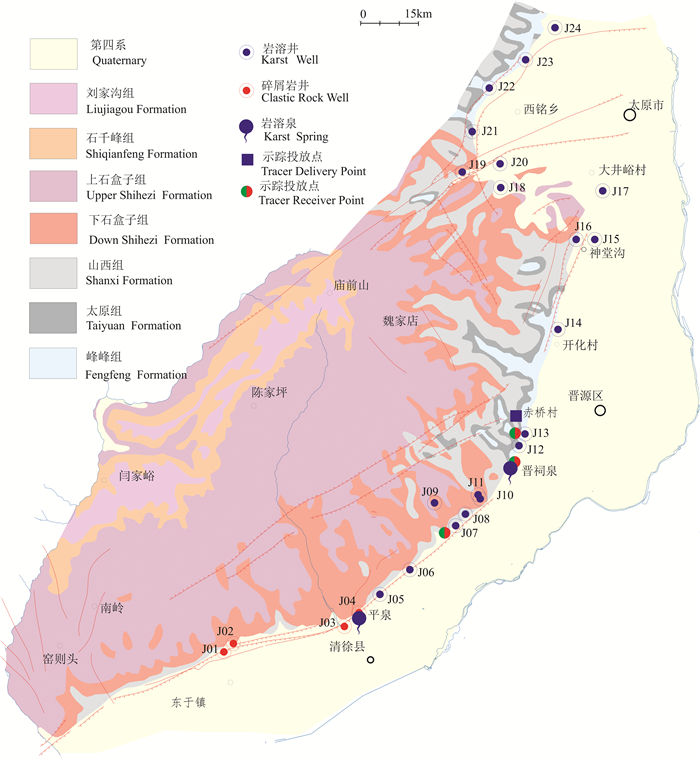
 下载:
下载:
